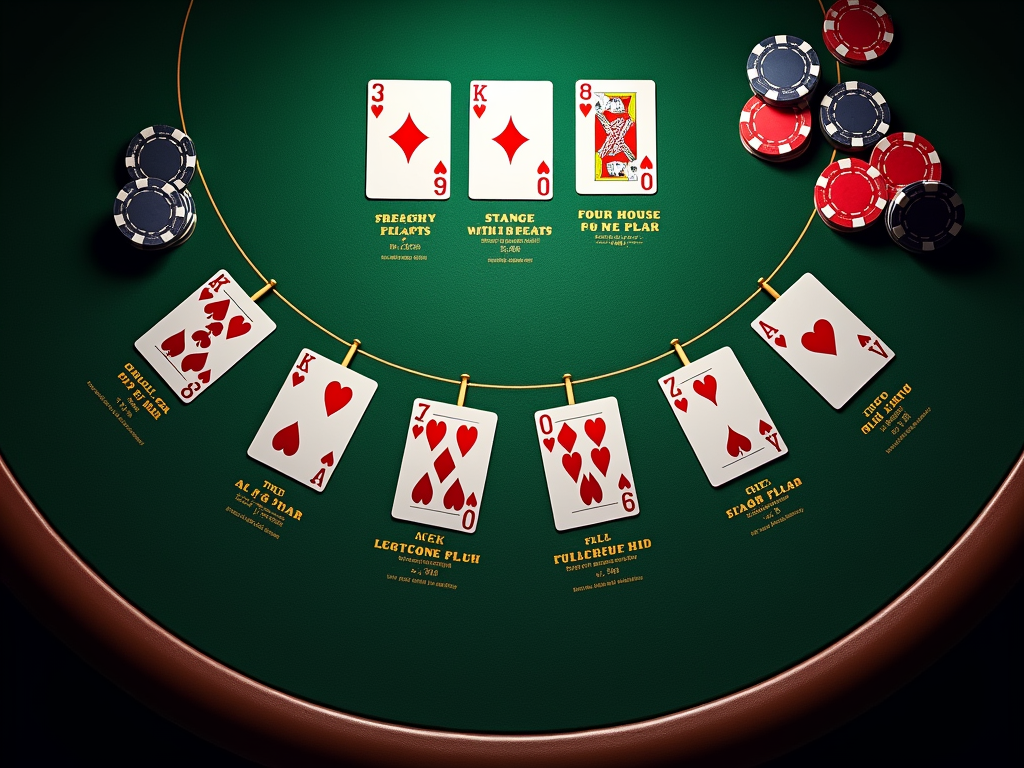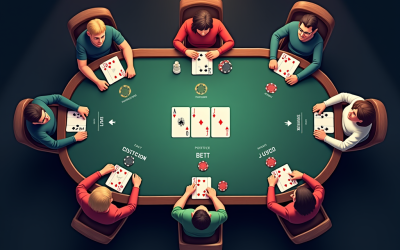Poker: A Game of Strategy and Psychology
Poker demands mastering both strategy and psychology to outmaneuver opponents at the table. The game has transformed since its 19th-century origins into a refined contest of skill that tests players’ abilities to leverage betting rounds, hand rankings, and table dynamics.
Key Takeaways
- Two primary paths lead to victory: building the strongest hand possible or executing successful bluffs against opponents.
- A standard 52-card deck, poker chips, dealer button, and blind markers form the essential equipment for proper gameplay.
- Understanding hand rankings from Royal Flush to High Card enables quick, effective decision-making during play.
- Texas Hold’em progresses through four strategic betting rounds: pre-flop, flop, turn, and river.
- Six betting options shape gameplay strategy: check, bet, call, raise, fold, and all-in.
Strategic Play and Table Awareness
I craft my strategy around reading opponents while staying mindful of my position and stack size. This balanced approach lets me identify optimal moments for aggression versus caution.
My focus stays fixed on maximizing value from strong hands while mixing in calculated bluffs to keep opponents guessing.
The Importance of Discipline and Learning
Smart bankroll management and emotional control matter just as much as technical poker knowledge. I maintain strict discipline with my buy-ins and avoid playing outside my skill level.
Through dedicated practice and study, I’ve learned to make decisions based on math and logic rather than impulse.
Adapting in a Dynamic Environment
The poker landscape continues shifting as players develop innovative strategies. I stay competitive by adapting my game while maintaining solid fundamentals. Success requires both patience to wait for premium spots and courage to seize opportunities when they arise.
From Casual Game to Global Phenomenon: Understanding Modern Poker
Modern poker has an incredible origin story that stretches back to the early 19th century United States. This card game evolved from a mix of fascinating influences, including the Persian game As-Nas and the French favorite Poque, to become the strategic masterpiece I know and love today.
The Art of Playing to Win
The basic premise of poker centers on mastering strategic gameplay and reading opponents while competing for the ‘pot’ – the collection of all bets made during a hand. I find that successful poker playing relies on two main paths to victory:
- Building the strongest hand possible using the cards dealt
- Successfully bluffing opponents into believing you have a winning hand
Each poker variant brings its own specific betting rules and gameplay mechanics, but they all share these core elements:
- Players place bets based on their confidence in their hand
- Action moves clockwise around the table
- Players can call, raise, or fold when it’s their turn
- The player with the best hand (or last one standing) wins the pot
The combination of chance, psychology, and skill makes poker stand out from other card games. I’ve seen how a player’s ability to calculate odds, read behavioral tells, and make strategic decisions under pressure can turn what seems like a simple betting game into a complex battle of wits.
The betting structure forms the backbone of poker’s strategic depth. Players must constantly weigh the strength of their hand against their opponents’ possible holdings while managing their chip stack throughout the session. This intricate balance of risk and reward creates the perfect environment for both casual entertainment and professional competition.

Essential Equipment and Table Setup for Poker Games
Starting a poker game requires specific equipment and proper setup to create an authentic playing experience. Let me walk you through the fundamental items and arrangements needed for a smooth game.
Core Equipment and Positions
The foundation of any poker game is a standard 52-card deck, split into four distinct suits: Spades (♠), Hearts (♥), Diamonds (♦), and Clubs (♣). Each suit contains 13 cards, ranging from Ace down to 2, with the Ace holding special status as it can be played as either the highest or lowest card in the sequence.
I’ve found that organizing the table layout correctly makes a huge difference in gameplay. The dealer button – a small disk marked with “D” – moves clockwise after each hand, helping track whose turn it is to deal. Next to the dealer position, you’ll find two crucial forced bets: the small blind and big blind. In a typical $1/$2 game structure, the small blind puts in $1, while the big blind contributes $2 before any cards are dealt.
Here’s what you need to set up a proper poker table:
- A clean, flat playing surface
- Poker chips in various denominations
- A dealer button
- Two blind markers (small and big)
- Playing cards (keep a backup deck handy)
- Comfortable seating for 2-10 players
Setting up your poker game correctly creates the right atmosphere and helps maintain order throughout play. The table should be large enough to accommodate all players comfortably while keeping cards and chips within easy reach.
I recommend positioning players with enough elbow room to handle their cards and chips without crowding. Each player should have clear visibility of the community cards in the center and access to their private hole cards without revealing them to others.
The chips should be arranged in neat stacks in front of each player, making it easy to count and bet. For home games, I suggest using different colored chips for various denominations to speed up gameplay and reduce confusion during betting rounds.
Master the Hand Rankings: Your Path to Winning Poker
Top-Tier Poker Hands
Understanding poker hand rankings is essential for making smart decisions at the table. I’ll guide you through the complete hierarchy of poker hands, starting with the most valuable combinations that can secure your victory in a competitive poker game.
The Royal Flush stands as the ultimate poker hand, consisting of A♠ K♠ Q♠ J♠ 10♠ all in the same suit. It’s incredibly rare but unbeatable. Just below that, you’ll find the Straight Flush, like 9♥ 8♥ 7♥ 6♥ 5♥ — five consecutive cards of the same suit. Four of a Kind follows, such as J♣ J♦ J♥ J♠ 4♦, where you have all four cards of the same rank plus any fifth card.
A Full House combines three cards of one rank with a pair of another (K K K 7 7), while a Flush features any five cards of the same suit (Q♣ 10♣ 7♣ 4♣ 2♣).
Common Winning Combinations
Moving down the rankings, you’ll encounter more frequent hands that can still win you plenty of pots. A Straight contains five consecutive cards of any suit (7♠ 6♦ 5♥ 4♣ 3♠). Three of a Kind shows up as three cards of the same rank plus two unmatched cards (9♠ 9♥ 9♦ K♣ 4♦).
Here are the remaining hand rankings from strongest to weakest:
- Two Pair: Two different pairs plus any card (A A 5 5 J)
- One Pair: A single pair plus three unmatched cards (10 10 8 4 3)
- High Card: Five unmatched cards, ranked by highest card (A K 8 5 2)
I recommend memorizing these rankings thoroughly — they’re the foundation of every poker decision you’ll make. By mastering these combinations, you’ll spot potential winning hands faster and make better choices during crucial moments in the game.
Remember, in situations where players hold the same type of hand, the highest-ranking cards within that hand determine the winner. For instance, if two players have two pair, the player with the highest pair wins.

Playing the Game: Texas Hold’em Betting Rounds
Understanding the Betting Flow
I’ve found that mastering Texas Hold’em betting rounds is crucial for new players looking to build their poker skills. The game starts with the pre-flop round, where each player receives two private hole cards. This initial betting round kicks off after the small and big blinds are posted, letting players decide if they want to call, raise, or fold based on their starting hand strength.
The flop brings the first three community cards face-up on the table, starting the second betting round. This critical stage often determines how players will approach the rest of the hand, as they now have five cards to work with (their two hole cards plus the three community cards).
Advanced Betting Stages
The turn card comes next, adding a fourth community card and opening another betting round. At this point, players who’ve stayed in the hand have a clearer picture of their potential winning combinations. The river card is the fifth and final community card dealt, leading to the last betting round where players make their final decisions.
The showdown occurs if multiple players remain after the river betting. Here’s what happens during each betting round:
- Pre-flop: Bets must match the big blind to stay in the hand
- Flop: Betting starts with the first active player left of the dealer
- Turn: Betting can increase significantly as hand strengths become clear
- River: Final chance to build the pot or bluff
During any betting round, players can check if there’s no existing bet, call to match a bet, raise to increase the betting amount, or fold to exit the hand. According to WSOP standard format, betting limits can vary based on tournament structure or cash game stakes.
The winning hand combines the best five cards from any combination of hole cards and community cards. I’ve noticed that successful players adjust their betting strategy throughout these rounds based on their hand strength and their opponents’ actions.

Your Betting Options Explained
Essential Poker Actions at the Table
I’ve found that mastering poker’s basic betting options creates a solid foundation for playing successful poker both online and at live tables. Let me break down the six core betting actions you’ll use in every game:
The betting options in poker give you different ways to manage your chips and make strategic decisions during play. Here are the key moves you need to know:
- Check: This lets you pass the action to the next player without placing a bet, but you can only check if no one has bet before you in the current round.
- Bet: As the first player to put chips in during a betting round, you’re setting the pace and forcing others to make decisions.
- Call: By matching the exact amount of the current bet, you stay in the hand without increasing the stakes.
- Raise: This aggressive move increases the current bet, forcing other players to pay more to continue in the hand.
- Fold: Sometimes the smart play is to give up your hand and save your chips for a better opportunity, though you’ll lose any chips already invested.
- All-In: When you push all your remaining chips into the pot, you can’t be forced out of the hand but can only win an amount equal to your total contribution from each opponent.
I recommend carefully considering your chip stack and position at the table before making any of these moves. Each action sends a specific message to your opponents and directly impacts your chances of winning the pot.
The stakes climb higher each time someone raises, so it’s critical to understand how your betting choices affect both your immediate odds and long-term success at the table. By using these options strategically, you’ll put pressure on opponents while protecting your own chip stack.

Sources:
PokerNews – Poker Hand Rankings
Wikipedia – Poker
Bicycle Cards – How To Play Poker | Basic Poker Rules for Beginners
World Series of Poker – How To Play Poker: Texas Hold’em (No Limit) Rules





